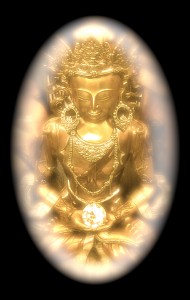Buddhism has a thing for numbered lists: Two Truths. Three Marks of Existence. Four Foundations of Mindfulness. Five Precepts. Six Paramitas. Seven Factors of Enlightenment. The Eightfold Noble Path. Twelve links of Dependent Origination. Thirty-two Marks of the Buddha. Fifty-one Mental Factors. Fifty-two Stages of the Bodhisattva Path. There’s a lot of stuff to remember and the lists are mnemonic devices that help keep everything straight.
Buddhist practice can be endlessly complicated. Some people like things with more details, more rules, more rituals, more practices, complex visualizations. If you are one of them, there is a Buddhism that is just right for you. There are 84,000 different Dharma doors.
Not me. I like things simple. My favorite ice cream is plain vanilla.
My practice is very simple. My numbered list contains only Five Practices:
- Be Present
- Be Open-Hearted
- Show Respect
- Have Courage
- Let Go
Five is as much as I can wrap my head around. If I stick with these five there is more than enough to keep me busy.
1) Being Present — The practice of Being Present involves mindfulness, both in dedicated sitting practice and in daily life. It also involves a commitment to whole-heartedness — if you are going to do something, do it all the way with your whole being. It also means showing up — be there to do what is needed — don’t evade responsibility for doing what has to be decided or done.
2) Be Open-Hearted — Open-Heartedness is the practice of commitment to the way of compassion, lovingkindness, empathy, tolerance and forgiveness. It is the practice of accepting people the way they are, no matter how different or deficient they may be. That doesn’t mean that you accept or approve of everything others do, and it doesn’t mean you don’t protect yourself from the harmful action of others. It just means that you keep them in the category of ”one of us.” All beings are ”one of us,” no matter how much they might seem otherwise. We say, in the metta chant, sabe satta, ”whatever beings there are.” We wish them happiness and freedom from suffering. Compassion and kindness are not just emotions to be cultivated as mental states. They involve our compassionate and loving activity in the world.
3) Show Respect — All things are interconnected. Who we are, our very life and existence, is dependent on the interdependent cooperation of all things. Can we show appreciation, gratitude, and respect for all things? This means not only bowing to and respecting all beings, including animals and plants. It means appreciating and caring for all things that come into our little circle of life. It means keeping air and water clear and unpolluted. It means appreciating and respecting the earth, and being a good steward. It means raising animals humanely and growing crops without toxins. It means keeping our living space orderly and clean. It means taking care of the things we own. It means respecting and caring for other people’s belongings. We bow deeply to all.
4) Have Courage — Don’t live your life out of fear, but live your life out of your convictions. Don’t be afraid to take a stand, to express a conviction. Don’t be afraid to love. Don’t be afraid to do what wisdom tells you needs to be done. This doesn’t mean that you should be in other people’s faces or take foolhardy risks. It just means that your existence should be life-affirming, not fear-based and avoidant.
5) Let Go — No one died and left you in charge of things. The world is not yours to control. Our practice is one of mindfulness, open-heartedness, respectfulness and courage. That doesn’t mean that everything we do turns out right, the way we had hoped and expected. It doesn’t mean that others always reward us or appreciate us for what we do. It doesn’t mean we get what we want. We still get old, and sick, and die. All relationships, even the one’s we care about most, even the good ones, all end eventually. If all goes well they end with our death or theirs, if all doesn’t go well, they end in acrimony. Nothing we like and want to hold onto remains constant. Change, entropy, habituation, and cycles of decline, transformation, and rebirth govern the multiverse. Our practice is a continual one of letting go, non-clinging, and acceptance, over and over. Just like when we do our sitting practice, the practice is one of continual letting go moment by moment. Letting go of our demands on the moment — how this moment ought to be — and accepting it just the way it is.
Do I personally embody these practices in my own life? No. They are horizons to be aimed at, not accomplishments to be attained. The practice-life never ends. We have to recommit to it moment by moment. We continually fall short of our practice goals, notice when we have fallen short, and recommit again, until we forget again. This is our human life.
Will these practices make you Enlightened? They haven’t made me Enlightened. But engaging in these practices is enlightened activity. When we engage in these practices all things express Buddha nature through us.
”Grass, trees, and lands are all embraced by this activity and together are radiant and endlessly express the inconceivable, profound Dharma. Grass, trees, fences, and walls bring forth the Teachings for all beings, usual people as well as sages. And they in accord extend this Dharma for the sake of grass, trees, fences, and walls. Thus, the realm of self-Awakening and Awakening others is fundamentally endowed with realization lacking nothing, and realization itself is actualized ceaselessly.” — from Dogen’s Bendowa [ref] translated by Anzan Hoshin Roshi and Yasuda Joshu Dainen Roshi [/ref]


I have wondered if there are different meditative practices that allow improvement in getting past obstacles. Does your tradition offer several meditative practices or is it basically one-size-fits all? I’d imagine there are several methods — which have you seen? [yeah, it is still me, I just started a different site — and this new site seems appropriate for your topic though I have yet to develop it 😉 ]
My sitting group is in a Soto Zen tradition, and we do shikantaza. Pretty much one size fits all. Koan practice is also an option, but I haven’t done any of yet. Prior to joining my currrent sitting group, I practiced within the Therevada tradition and utilized anapansati, vipassana, walking meditation, body sweeping, and the brahma-viharas. I also did a lot of Krisnamurti-type choiceless awareness, and had some more limited experience with Tibetan diety visualizations, seven-point mind training, subtle body meditations, tong-len and dzogchen. I appreciated a talk I heard Tsoknyi Rinpoche give in which he talked about one’s personal meditation space as being like a windows-type GUI with many meditative applications on the desktop. One opened the application one needed in the moment, and switched to another application when that was no longer needed. Too, distracted, try one-pointed focus on the breath. Too tightly focused, open up to choiceless awareness. Too dry, try some metta, etc. That made a lot of sense to me, although it presupposed one had sufficient wisdom to genuinely know what is needed in the moment, and one wasn’t just flitting from one technique to another as a method of avoidance. Right now, I am very happy with the simple practice of shikantaza, however and don’t feel a call to try anything else. It feels very similar to dzogchen, by the way — I think if one could discover the origin of dzogchen within Nyingmapa history one would probably detect some Ch’an influence (despite the legend of the Council of Lhasa).
Great reply Seth. I agree that both choosing a method and jumping between methods by yourself could easily simply be “another method of avoidance” or reinforcement of the jumping mind.
In the VajrayÄna tradition, as you know, that is why they emphasize a need for a teacher who knows you well to help prescribe for you in order to avoid such silliness. But also, as you know, such a relationship comes with many potential pitfalls. You seem to understand the options far better than I do. Having some effective method is a great beginning — and perhaps the best, in the end. Understanding the silliness of our own motivations, as you point out, is key.
I will have to read up on the “Legend of the Council of Lhasa” for the origin of dzogchen. I am a newbie — thanx.
BTW, I lived in Japan for 7 years. One-Size-Fits-All is a major cultural meme there — and suffocating for this American. I often see Americans embracing it as “Zen” instead of understanding it as Japanese.
Sabio,
Re: The Council of Lhasa — The Tibetans say that in the 8th century King Trisong Detsun was unsure of whether Tibetan Buddhism should follow Indian Madhyamaka or Chinese Ch’an. A debate was conducted at Samye Monastery between Hoshang Mahayana from China and Kamalasila from India and Kamalasila won. Hoshang was sent packing back to China and all Ch’an texts were gathered up and destroyed. Supposedly Ch’an, therefore, had no influence on the further development of Buddhism in Tibet. Except, I don’t believe that is true given the similarity between dzogchen and shikantaza.
cool, thanx, that was very helpful — I will use it in a post.
Ah the vagaries of history.
May I make a suggestion that you only moderate comments from first time commenting folks.
Done!